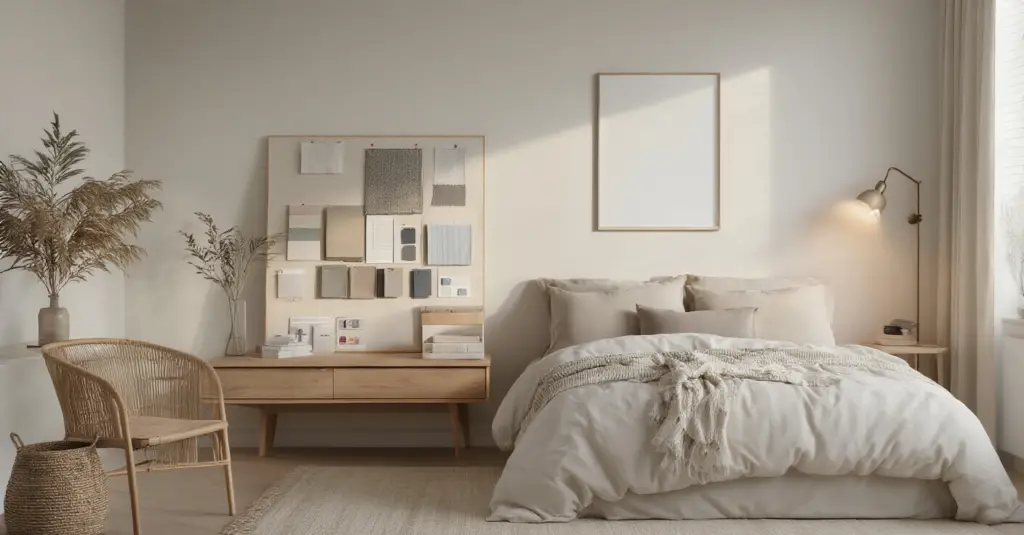You know what people always ask me about design? It’s not about the hottest color trend or the most expensive sofa. It’s some version of this: “How do I make my home beautiful, but also make it work… for my kids, for my aging mom, for me in ten years?” They see these picture-perfect rooms online and know, instinctively, that they wouldn’t last a day in their real, messy, wonderful lives.
And that’s where the conversation about wall art comes in, because it’s a perfect example of how we get design wrong. We treat it like the final, decorative fluff. But I see it as one of the most powerful tools we have to make a space feel personal, safe, and truly supportive. When we talk about wall art, we’re not just talking about filling a blank space. We’re talking about creating a room that can calm an anxious mind, guide someone with low vision, or bring a joyful memory to a grandparent. This is about making your sanctuary work for you and the people you love, today and tomorrow.
Strategic Planning: Laying the Foundation for Your Bedroom Gallery (Part 1)
Before you fall in love with a piece of art online, we need to talk strategy. I know, it sounds boring, but this is the part that saves you money, time, and a dozen poorly patched nail holes. Think of this as creating a roadmap for your room. A good plan ensures that what you hang on your walls does more than just look pretty—it contributes to the peace and function of the space.
1. Define Your Bedroom’s Desired Mood and Aesthetic
Can we all just agree to stop starting with “What’s my style?” It’s a trap. It boxes you into words like “farmhouse” or “mid-century modern” and makes you feel like you’ve failed if you like a lamp that doesn’t fit the label. The real question is: “How do you want to feel in this room?” Do you need a calm, uncluttered space to decompress? Or a vibrant, energizing room to help you wake up?
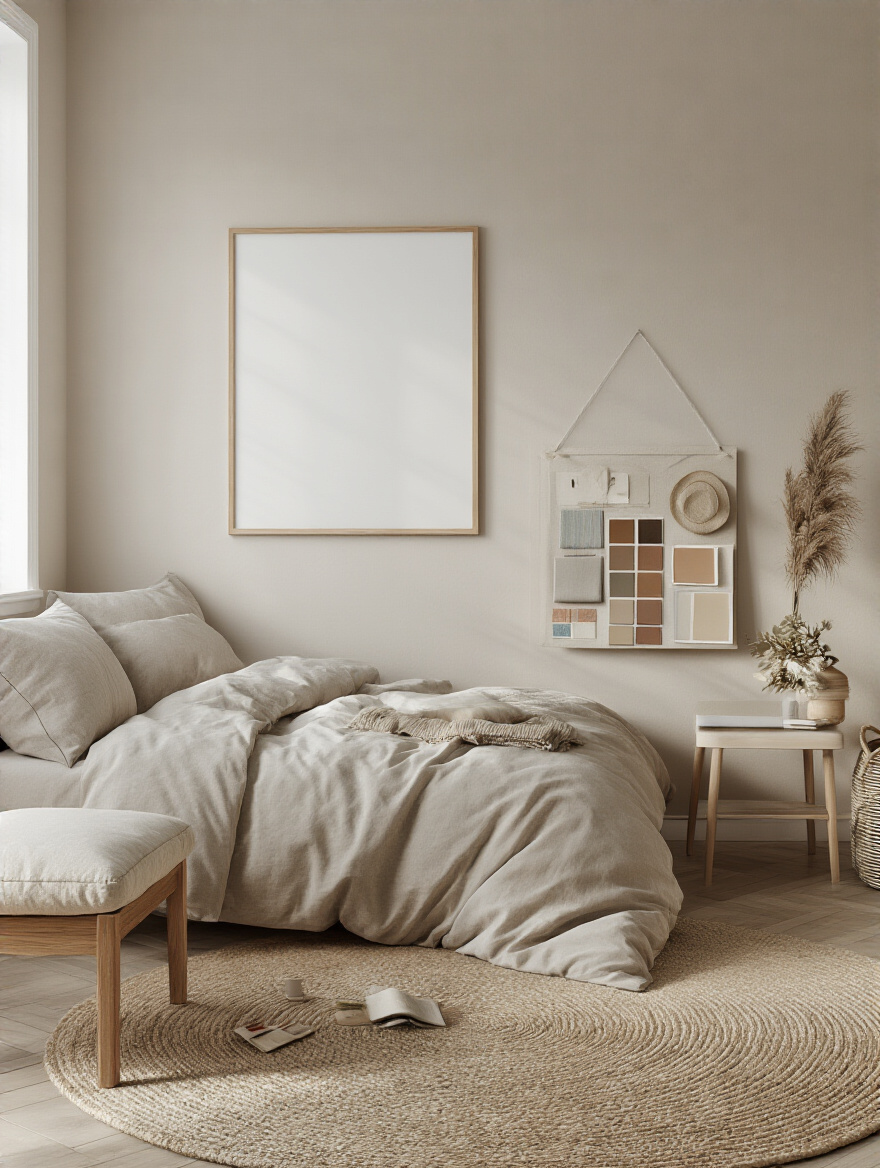
Start with feeling-words: Serene. Cozy. Playful. Minimal. Once you have those, you have your North Star for every single choice, from a giant abstract painting to a tiny framed photo. This isn’t just fluffy designer-speak; creating a room with a clear emotional goal is a core principle of good, accessible design. For someone with anxiety or sensory sensitivities, a visually “calm” room isn’t a style—it’s a necessity.
2. Measure Your Wall Space for Optimal Art Placement
I once visited a client who had this stunning, expensive piece of art. It was hung so high above their bed you practically had to crane your neck to see it. They had followed some “rule” about a certain height from the ceiling. But the art felt like it was floating away, disconnected from the very room it was supposed to anchor. We brought it down so it related to the headboard, and suddenly, the whole room just clicked into place.

So, let’s get practical. Measure your wall, but more importantly, measure the furniture the art will hang above. The common advice—that art should be about two-thirds the width of the furniture below it—is a great starting point. And hang it so the center of the piece is at eye level, roughly 57-60 inches from the floor. But remember, “eye level” is different for someone in a wheelchair or someone who spends most of their time in bed. Good design meets people where they are.
3. Analyze Existing Room Colors and Furnishings for Harmony
Harmony doesn’t mean “matching.” Please, do not go out and buy a piece of art with the exact shade of blue from your throw pillows. Your room will look like a hotel chain. Harmony is about finding pieces that have a conversation with the rest of the room. It’s about creating a cohesive visual story so the eye (and the mind) can rest.

Look at the undertones in your room. Is your gray paint warm or cool? Is your wood furniture reddish or ashy? The art you choose should complement that. A chaotic, visually cluttered room can be genuinely stressful and confusing, especially for older adults or anyone with cognitive challenges. Creating a harmonious space is an act of care. It makes the room easier to be in, and that’s the entire point.
4. Sketch Out Potential Layouts and Groupings on Paper
This is the shortcut I wish everyone knew. Before you commit to a single nail, grab some painter’s tape or craft paper. Cut out the exact shapes and sizes of the frames you’re considering and tape them to the wall. Live with it for a day or two. Walk by it, look at it from the doorway, look at it from your bed.
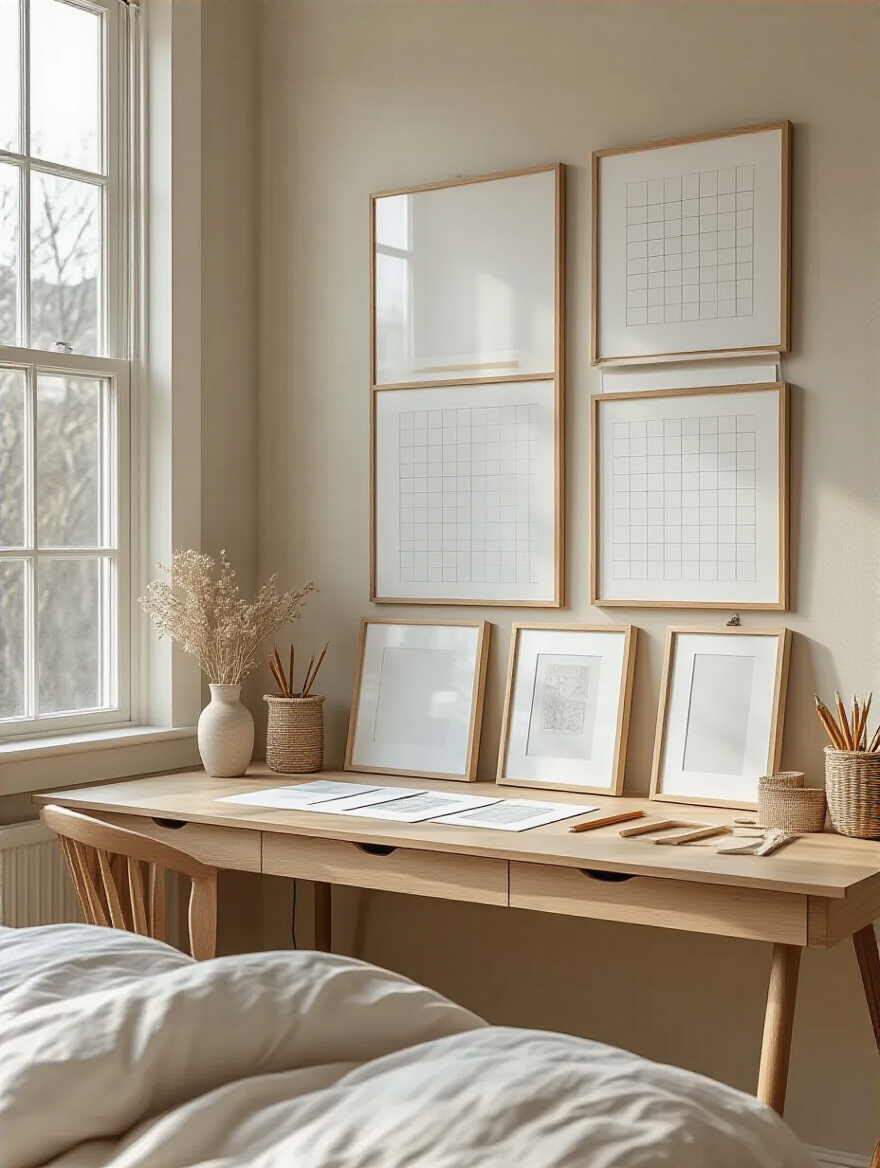
This simple step does more than just prevent mistakes. It saves you physical effort and the frustration of patching walls. For someone with limited mobility or energy, doing something once, correctly, is everything. This little bit of prep work ensures the final result feels intentional and balanced, not like a happy accident.
Strategic Planning: Laying the Foundation for Your Bedroom Gallery (Part 2)
Now that we’ve laid the groundwork for where and what size, let’s talk about two crucial elements that people often treat as afterthoughts but can completely define the success of your bedroom’s design: light and money.
5. Consider Lighting Sources to Highlight Your Art Effectively
Bad lighting can kill great art. It can wash out colors, create weird glare, and leave your favorite piece literally in the shadows. But for so many people, good lighting is more than just an aesthetic choice—it’s an accessibility feature. As we age, our eyes need more light to see clearly. Good, layered lighting helps prevent falls and makes a space feel safer and more comfortable.
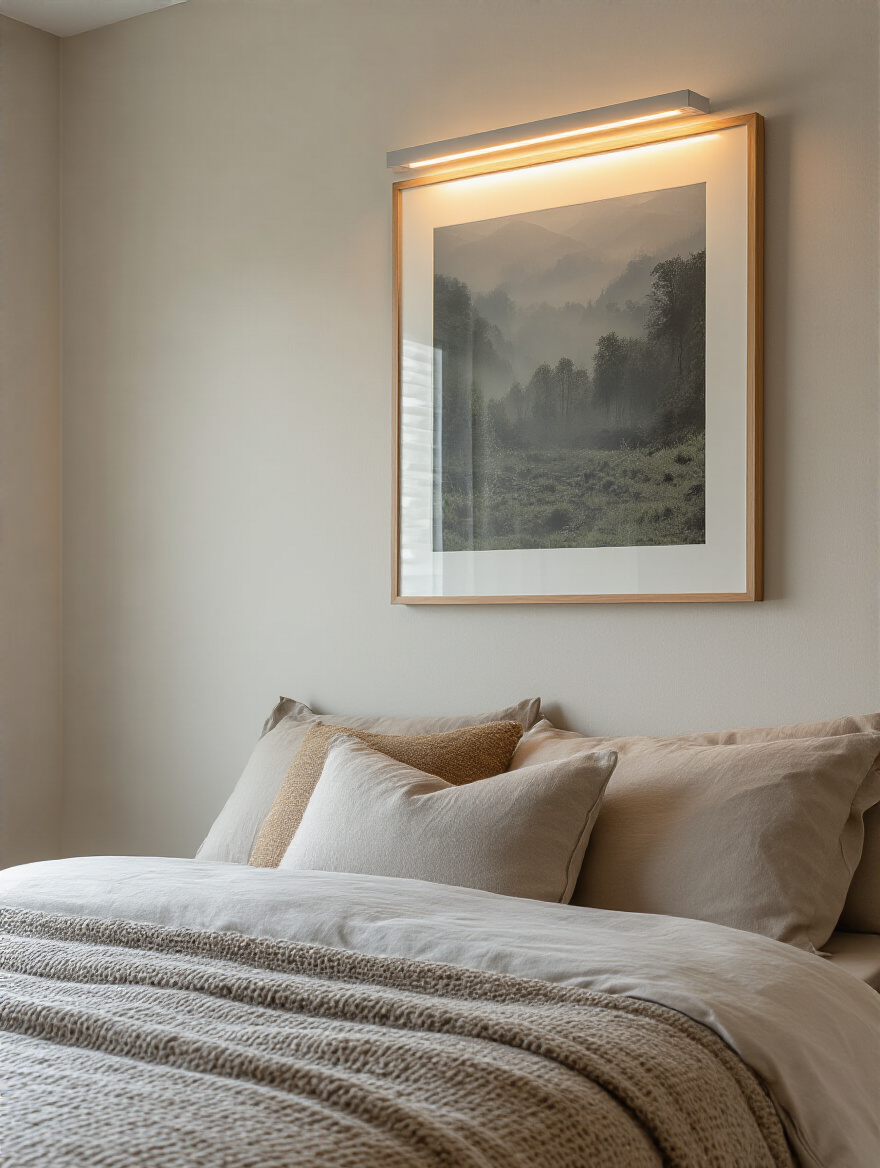
So when you’re thinking about your art, think about how it will be lit. A picture light mounted above a frame can add a touch of drama and provide focused light. Smart bulbs are a game-changer here. You can change the warmth and intensity with your voice or an app, which is incredible for anyone with mobility challenges. You can program a gentle “wake up” scene or a dim, “wind down” scene that makes the art part of your daily rhythm.
6. Set a Realistic Budget for Your Wall Art Investments
Let’s talk about the idea that great art has to be expensive. It doesn’t. Some of the most meaningful and beautiful wall art I’ve ever seen in a client’s home was a collection of their child’s framed drawings or a beautifully printed photograph from a family vacation. Good design is not about having a big budget; it’s about making thoughtful, personal choices.
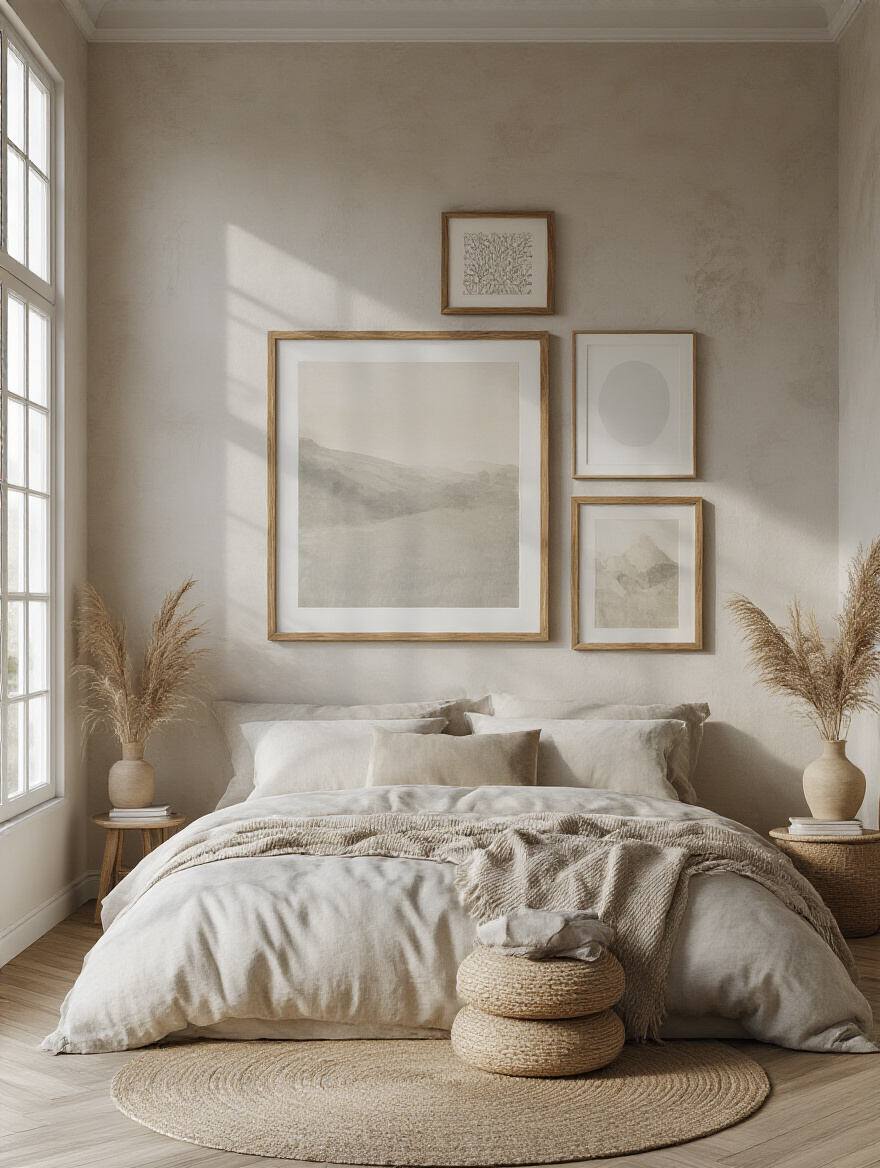
Decide what you’re comfortable spending and stick to it. And please, remember to budget for framing! Framing can often cost as much as the print itself, and it’s a surprise no one enjoys. A simple, affordable print in a high-quality frame will always look better than an expensive piece in a cheap, flimsy one. The goal is to build a collection you love over time, not to fill the walls overnight.
Curating Your Collection: Smart Choices & Seamless Installation (Part 1)
With a solid plan in hand, we can now move on to the fun part: choosing the art and getting it on the walls. This is where your personality truly starts to shine, transforming a well-planned space into a room that feels like a genuine extension of you.
7. Choose Artwork That Reflects Your Personality and Interests
This might seem obvious, but you’d be surprised how many people buy art because it “matches the sofa” or it’s on-trend. Your bedroom is your most personal space. The art in it should mean something to you. It could be a landscape of a place you love, an abstract that just makes you feel calm, or a quirky print that makes you smile.
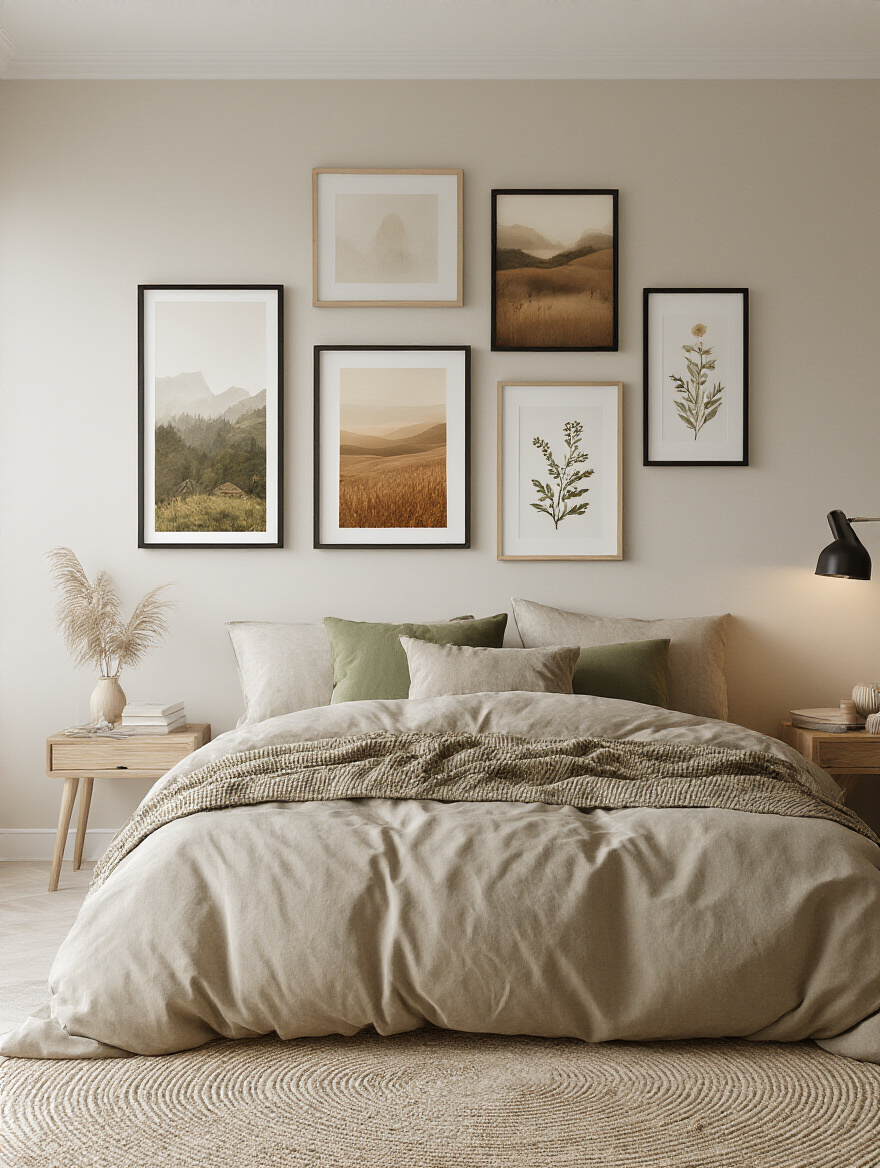
This is especially important in multigenerational homes. Surrounding an older family member with familiar images, personal photos, or art that reflects a lifelong passion can be incredibly grounding and comforting. It reinforces their identity and sense of self. Your walls tell a story, so make sure it’s one you love to hear every day.
8. Explore Various Art Mediums Beyond Traditional Prints
Let’s move beyond the flat, framed print. Introducing different textures and materials is a fantastic way to add depth and interest to a room. Think about a woven wall hanging, a carved wood panel, or a set of ceramic plates. These pieces add a tactile quality that is so inviting.
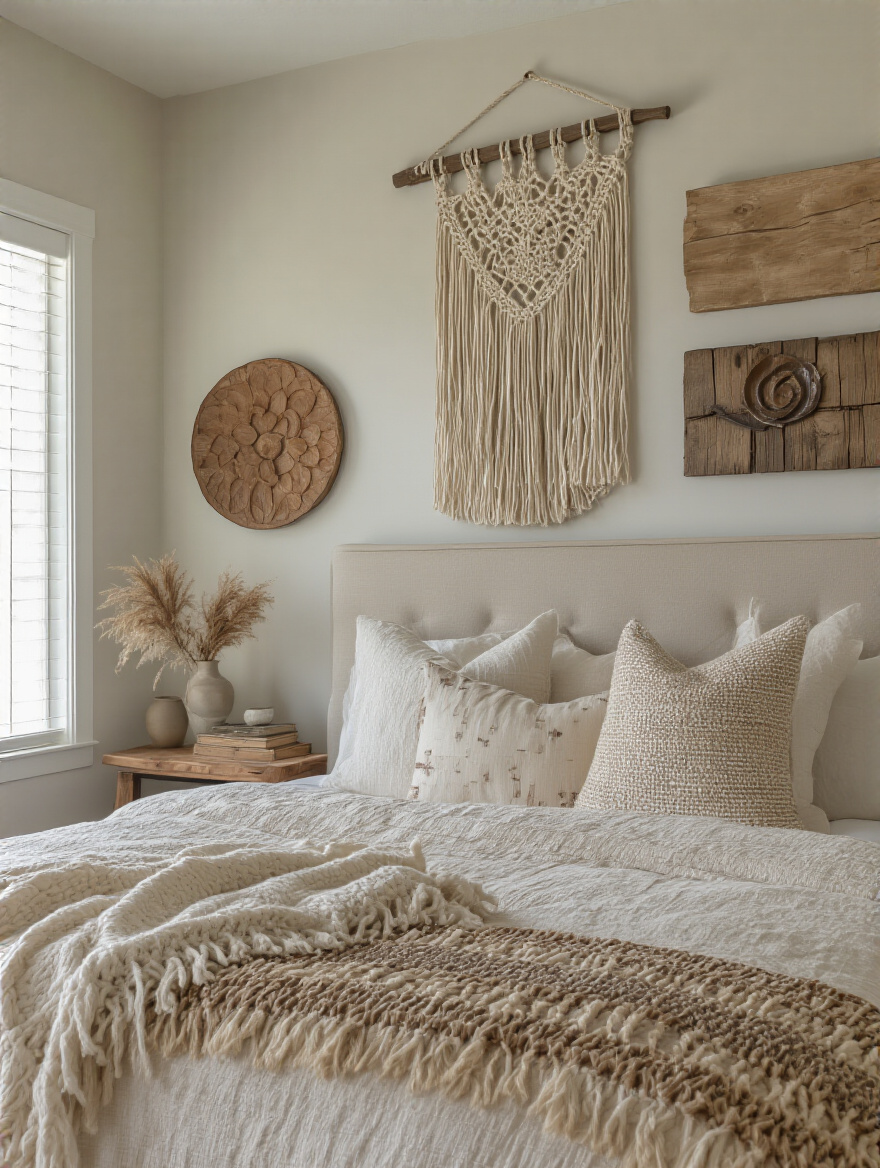
For someone with low vision, a piece of art they can experience through touch can be a beautiful and inclusive addition to a room. The play of light and shadow on a three-dimensional object is also more dynamic and engaging than a flat surface. Don’t be afraid to mix it up; the combination of a soft tapestry with a sleek metal sculpture can be stunning.
9. Balance Art Size with Wall Proportions to Avoid Overwhelm
We touched on this in planning, but it’s worth repeating: scale is everything. The most common mistake I see is art that is too small for the wall. It ends up looking like a postage stamp on a giant envelope, making the whole room feel unbalanced and unfinished. A blank wall feels better than a wall with teeny, apologetic art.
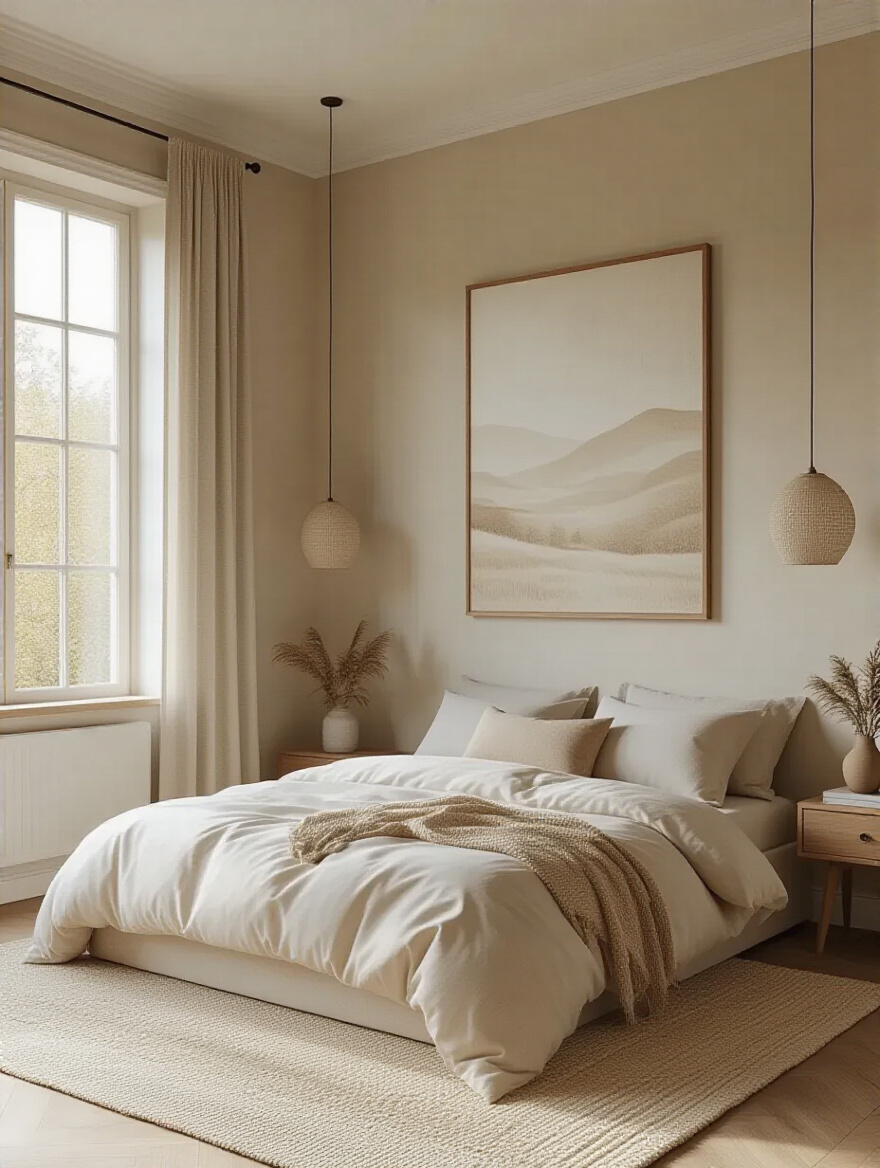
If you have a big wall, go for a big statement piece or a tightly grouped gallery wall that reads as one large unit. This creates a clear focal point and helps the room feel intentional and confident. Conversely, in a small nook, a single, beautifully framed small piece can feel like a hidden gem. Trust your gut—if it feels off, it probably is.
10. Master Secure Hanging Techniques for Different Wall Types
This is non-negotiable. An improperly hung piece of art is, at best, a costly mistake and, at worst, a serious safety hazard. A heavy mirror or frame falling in the middle of the night is terrifying, and absolutely preventable. Knowing what’s behind your wall is the first step.
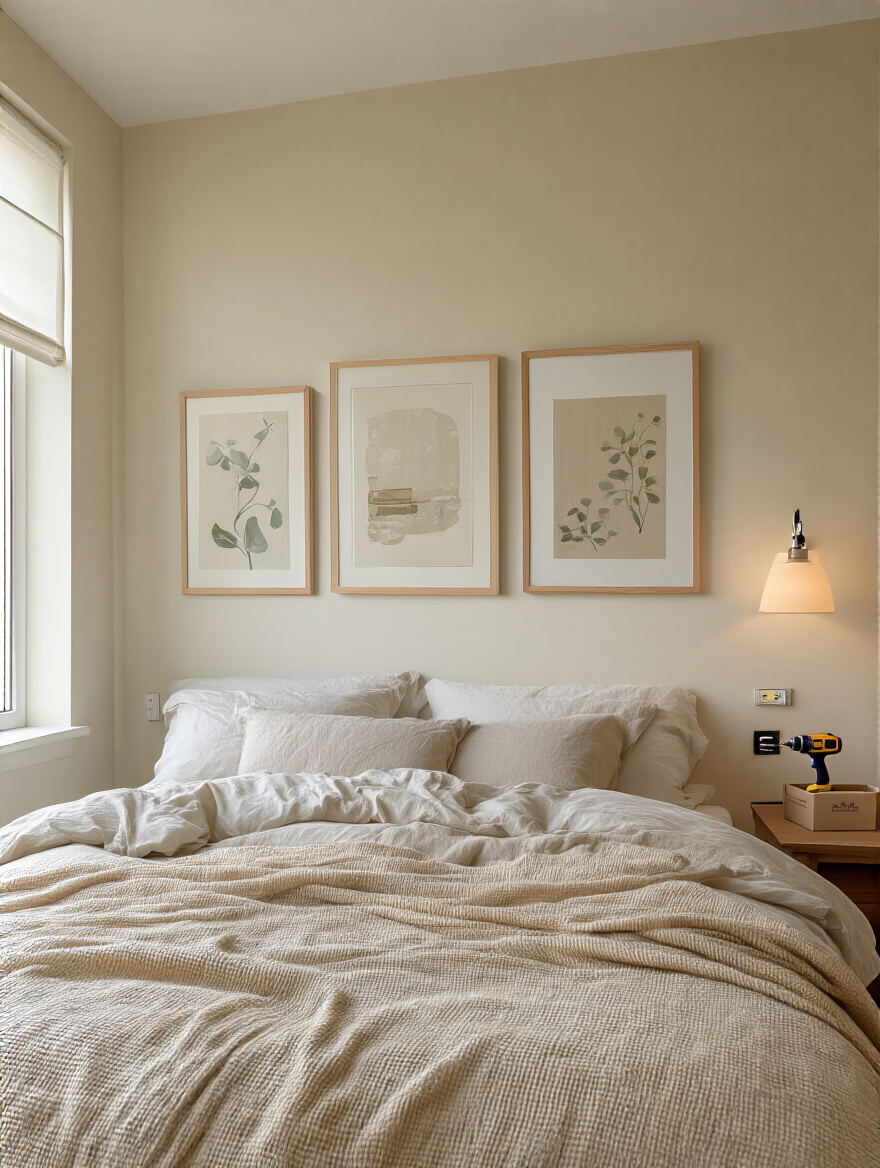
Most modern homes have drywall, which is basically useless for holding a heavy screw on its own. You need to either find the wooden stud behind it or use a proper wall anchor. And if you’re hanging something heavy, use two anchor points. It distributes the weight and keeps the frame level. This isn’t just about protecting your art; it’s about creating a safe environment, especially in a home with kids or anyone who might be unsteady on their feet.
Curating Your Collection: Smart Choices & Seamless Installation (Part 2)
Now that your art is chosen and hung securely, let’s look at a couple of classic ways to arrange pieces that can bring a whole new level of polish and personality to your bedroom walls.
11. Implement Gallery Walls for a Dynamic, Cohesive Look
Everyone loves a gallery wall, but they can go wrong so quickly, ending up looking like a cluttered mess. The secret to a great gallery wall is a unifying theme. It doesn’t have to be rigid—the theme could be a color palette, a subject matter (like all botanical prints), or even just the frame style.

I often recommend creating gallery walls of family photos in hallways or living rooms, but in a bedroom, it’s a chance to be more personal. A collection of photos from a favorite trip, a series of your own drawings or paintings, or vintage prints you’ve collected over time. Lay everything out on the floor first to get the spacing right before you hang a single thing. It’s the best way to ensure the final result is a beautiful, cohesive story, not just a random collection of frames.
12. Select Frames That Enhance, Not Distract From, the Artwork
A frame’s job is to serve the art, not overpower it. Think of it as a quiet supporting actor. A simple, clean frame often does the best job of letting the art speak for itself. You can create a very sophisticated look by using the same style of frame for a whole collection of art, even if the art itself is very different.
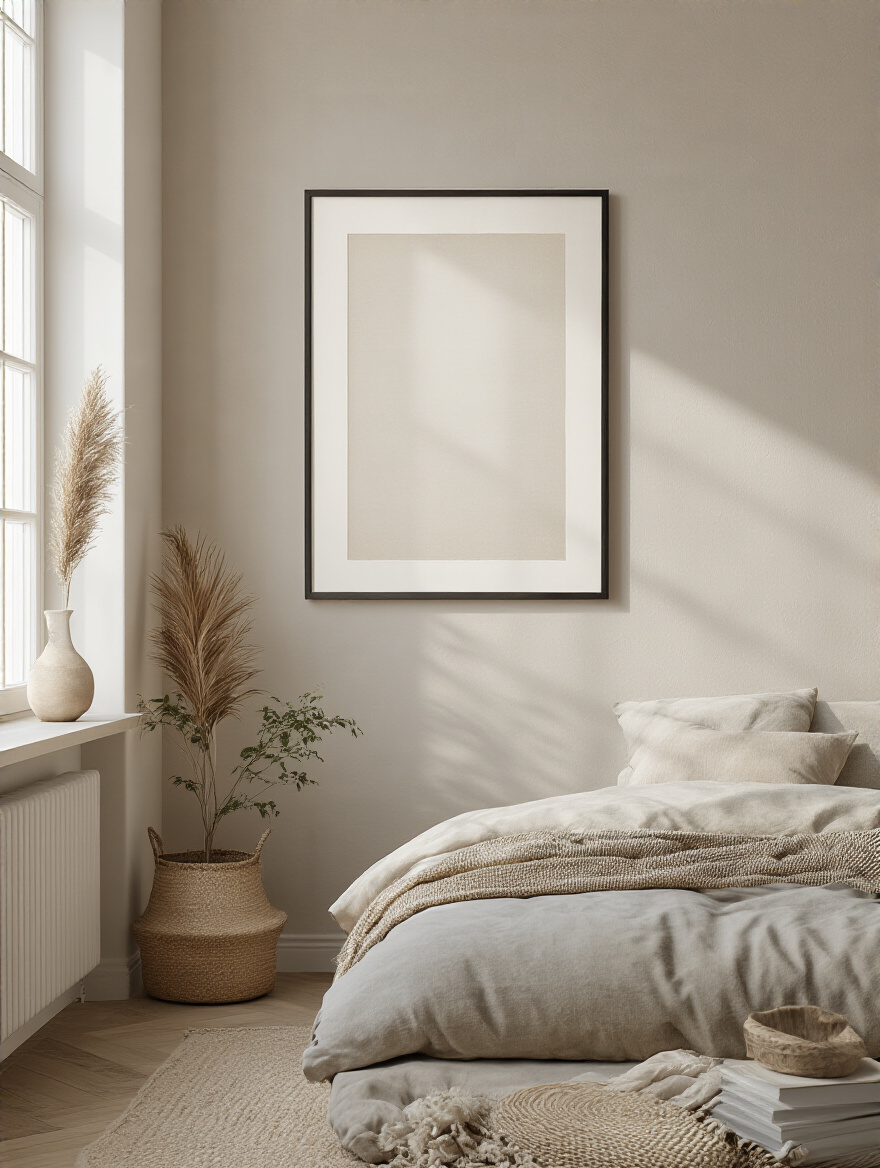
And here’s a pro tip for accessibility: consider museum glass or acrylic. It’s more expensive, but it dramatically reduces glare, which can make a huge difference for someone with vision impairments. It allows the art to be seen clearly from any angle without a distracting reflection of the window or a lamp. A simple black, white, or natural wood frame is almost always a timeless choice.
Elevating Aesthetics: Creative Styling for a Captivating Bedroom (Part 1)
With your art curated and beautifully framed, it’s time to think like a stylist. These next ideas are about adding those layers of depth and personality that take a room from “nicely decorated” to “uniquely yours.”
13. Mix Textures and Dimensions for a Rich Visual Experience
We’ve been trained to think of walls as flat planes, but they don’t have to be. Introducing art with texture and dimension creates such a rich, inviting experience. This could be a painting with thick, impasto brushstrokes, a piece of reclaimed wood, or a macrame wall hanging.
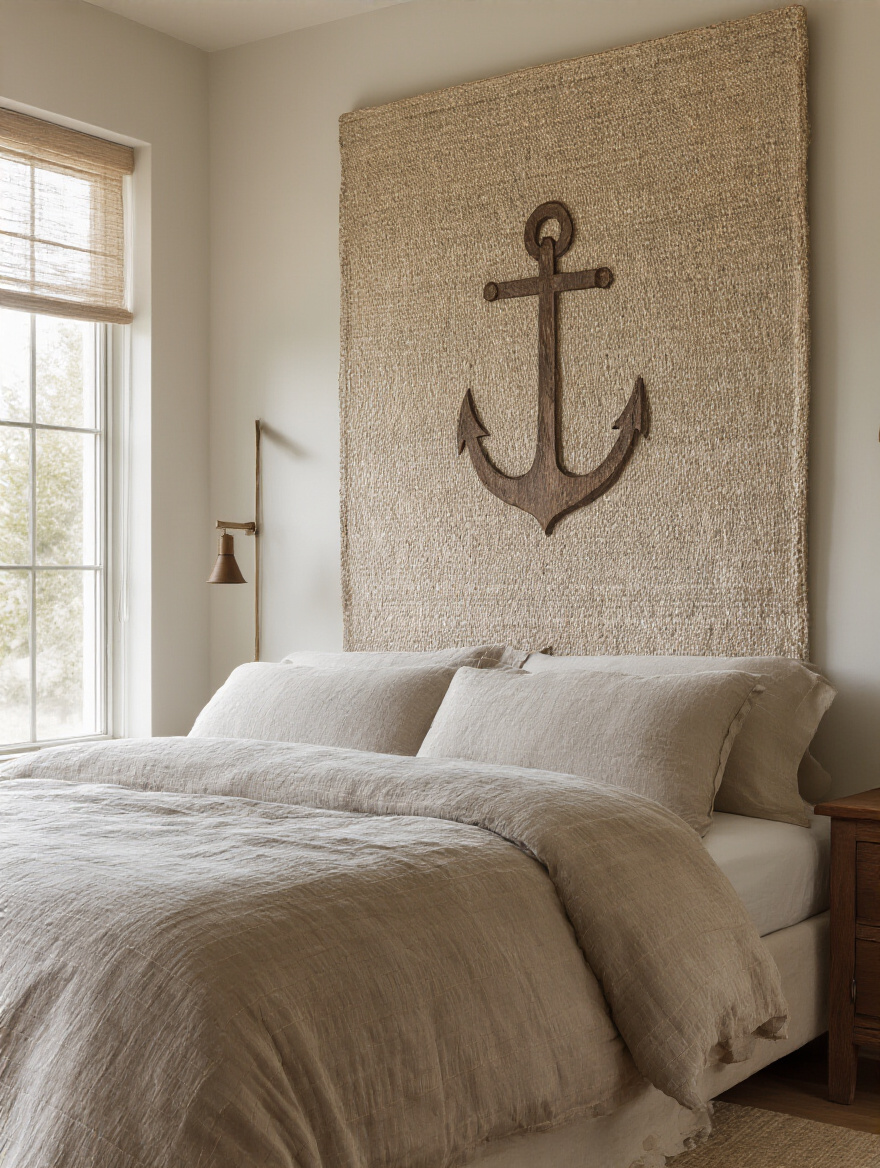
This is another area where universal design principles shine. A visually rich environment with varied textures can be more stimulating and engaging for everyone. For someone with low vision, a tactile piece offers another way to appreciate the art. It’s about creating a multi-sensory space that feels layered and lived-in.
14. Incorporate Mirrors Strategically to Amplify Light and Space
Mirrors are magic. They bounce light around, make a room feel bigger, and can double the view of a window. In a small or dark bedroom, a large, well-placed mirror can be completely transformative. Placing one opposite a window is the classic trick to maximize natural light.
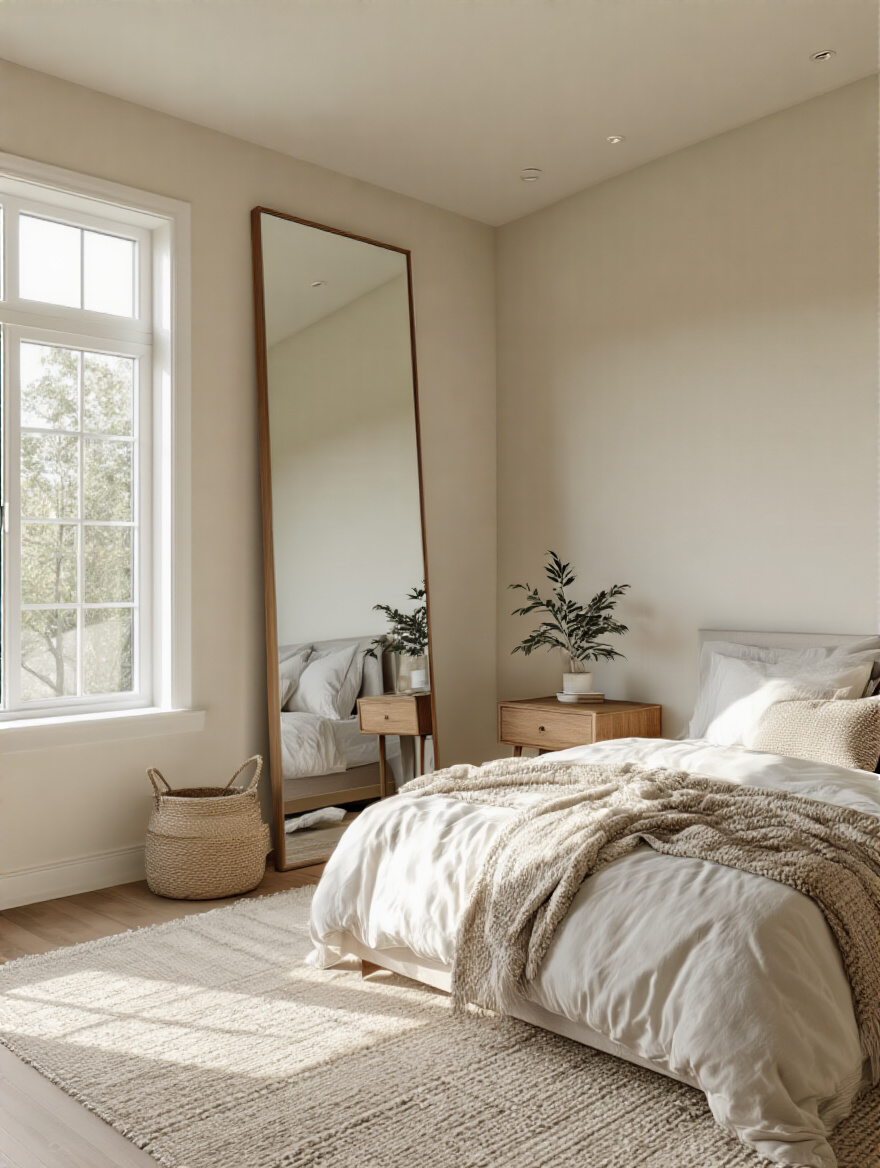
A quick word of caution: be mindful of placement. In a bedroom for an older person, particularly someone with dementia or cognitive confusion, an unexpected reflection can sometimes be disorienting. However, in most cases, a beautiful mirror, treated as a piece of art with an elegant frame, adds a touch of glamour and so much function.
15. Layer Artwork with Shelves or Furniture for Depth
One of my favorite looks is leaning art. A large canvas leaning against a wall on top of a dresser, with a smaller framed photo and a plant in front of it, creates an effortless, collected-over-time feeling. This layering adds so much visual depth and personality.
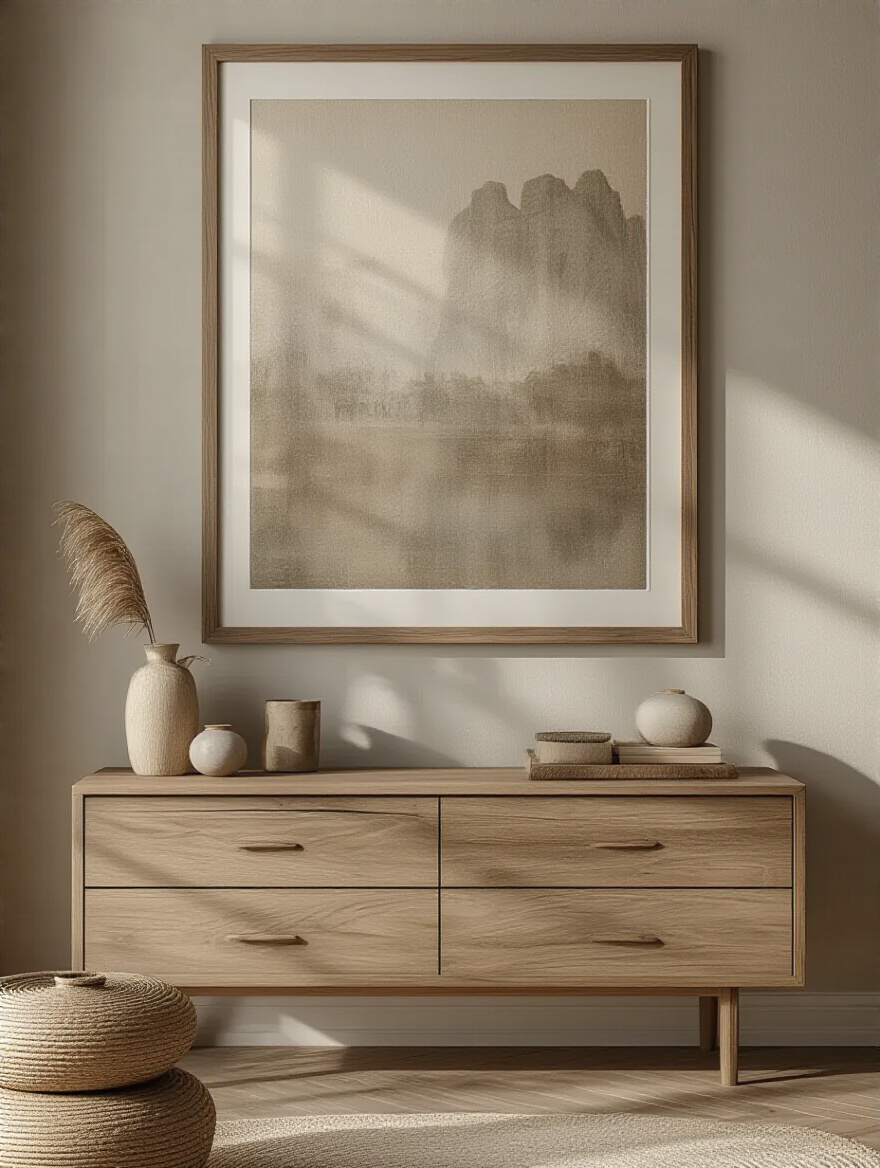
Picture ledges are perfect for this. They allow you to easily rotate art without creating new holes in the wall. You can create a beautiful, evolving display of your favorite things. This is design that adapts with you, allowing you to refresh your space with your changing tastes and memories, which is what a truly livable home is all about.
16. Use Wall Decals or Murals for Customizable Large-Scale Impact
Don’t have the budget for a giant piece of art or the courage to paint a mural? Wall decals are your best friend. The quality today is incredible, and they can create a huge impact with minimal commitment. You can find everything from subtle geometric patterns to full-scale forest scenes.

This is a fantastic solution for renters, kids’ rooms that will need to change as they grow, or anyone who just loves to switch things up. It’s a low-risk, high-reward way to create a powerful focal point and completely change the feel of a room in an afternoon.
Elevating Aesthetics: Creative Styling for a Captivating Bedroom (Part 2)
The final touches are about refining your style and ensuring your bedroom remains a dynamic, personal, and evolving space. These ideas offer even more ways to express yourself and keep your sanctuary feeling fresh.
17. Experiment with Leaning Art Against Walls for a Casual Vibe
We touched on this with layering, but leaning art deserves its own moment. It’s an intentional choice that says, “I’m not trying too hard.” It’s relaxed, chic, and incredibly versatile. A large, floor-length mirror leaned against a wall can make a small room feel palatial, while a collection of smaller frames on a mantel or shelf feels personal and curated.
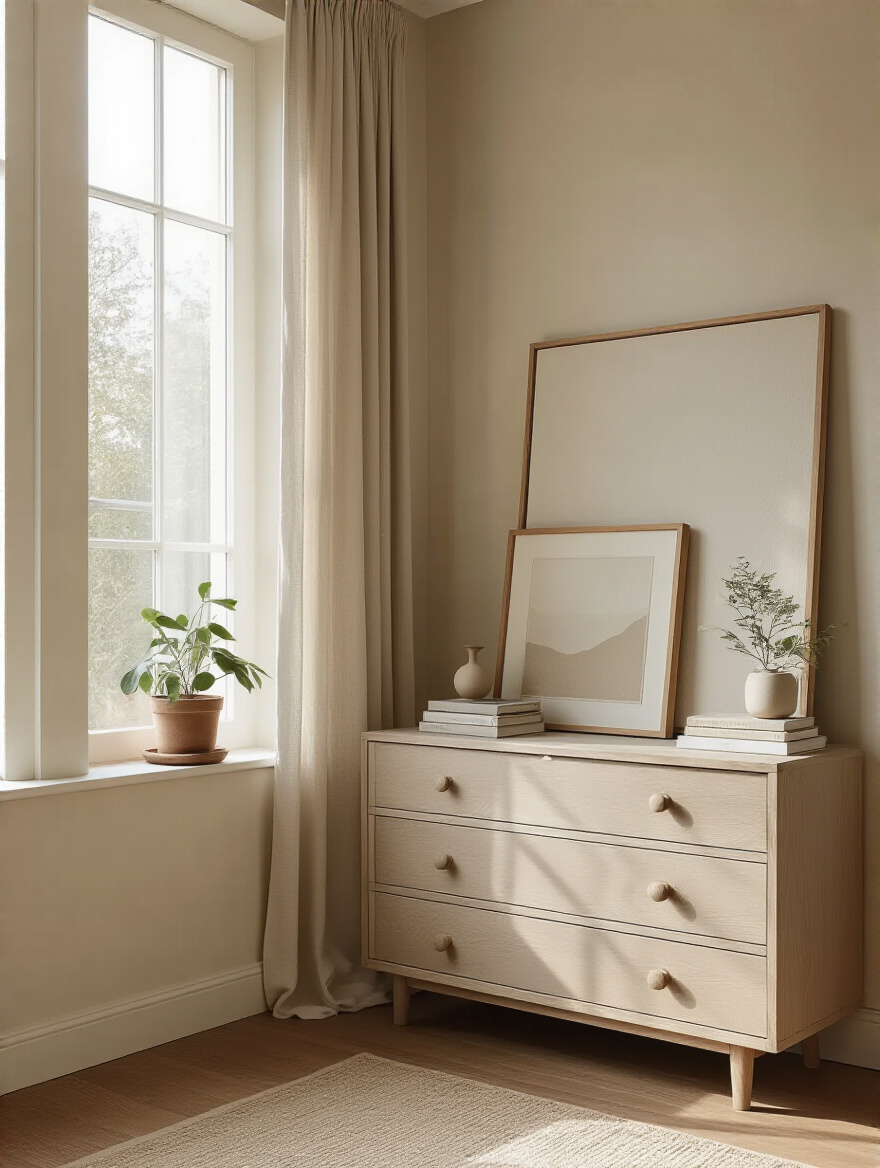
The key to making this work is to be deliberate. This isn’t just “I haven’t gotten around to hanging it yet.” It’s about composition. The one non-negotiable? Safety. Make sure larger pieces are stable and in a low-traffic area where they won’t get knocked over, especially in a home with kids, pets, or anyone with mobility aids. A little bit of museum putty on the corners can add invisible stability.
18. Design a Thematic Grid Wall to Tell a Visual Story
A grid wall is the more structured cousin of the eclectic gallery wall. It involves hanging a series of same-sized pieces in a perfect grid. This creates a very clean, high-impact, and modern look. It’s particularly effective with a series of black and white photos or a set of related prints, like botanical illustrations or architectural drawings.
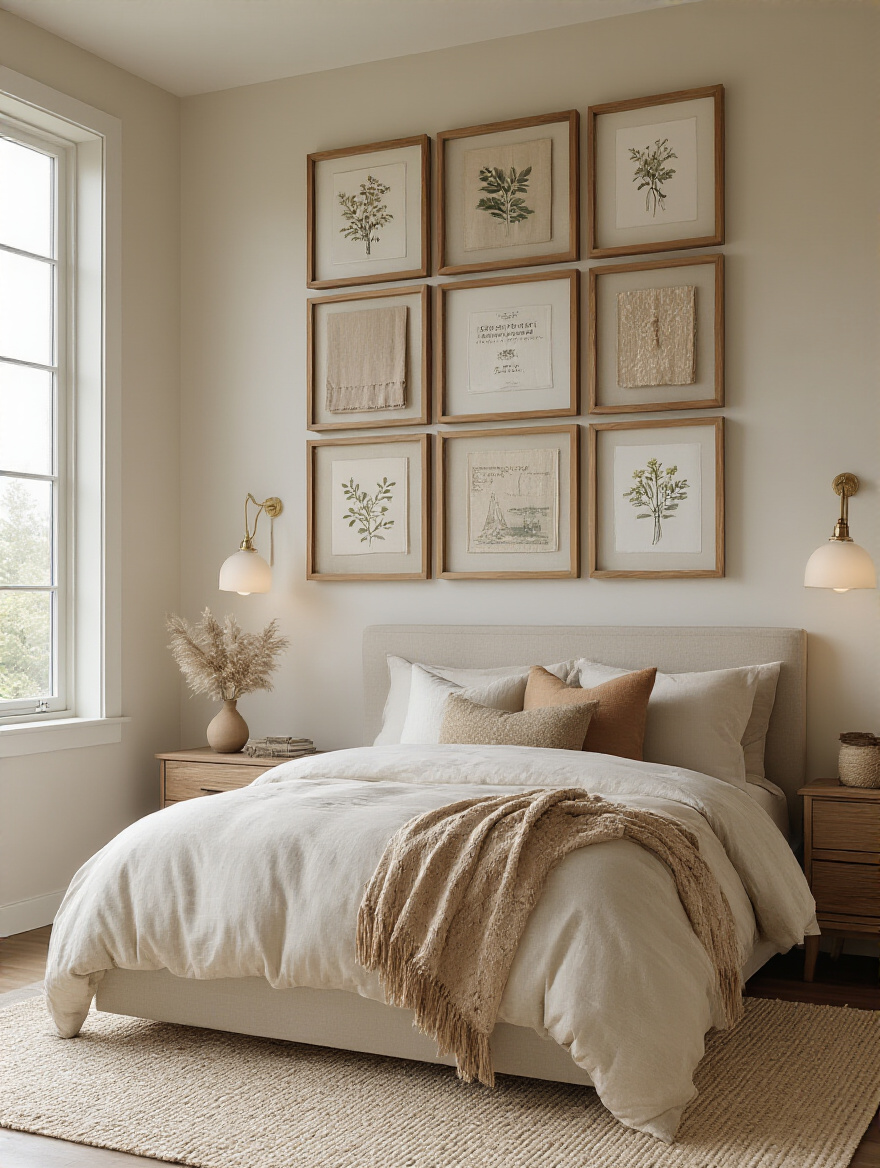
The precision of a grid is calming and organized, which can be a wonderful feeling to have in a bedroom. It takes some careful measuring, but the result is a powerful, unified statement. This is a great way to display a series of your own photographs, turning a personal hobby into a stunning piece of custom art.
Refining & Sustaining: Advanced Personalization and Care (Part 1)
Your art is chosen, hung, and styled. You’re almost done! But just like a garden, a beautiful room needs a little tending. This final section is about the long-term relationship you have with your space—how to care for it and keep it feeling fresh.
19. Integrate Smart Lighting to Adapt Mood and Highlight Pieces
We talked about smart lighting for function, but let’s talk about it for fun. Imagine tapping a “Movie Night” button on your phone, and the lights dim, the picture light over your favorite painting glows softly, and the room instantly feels cozy and intimate. That’s the power of smart lighting.
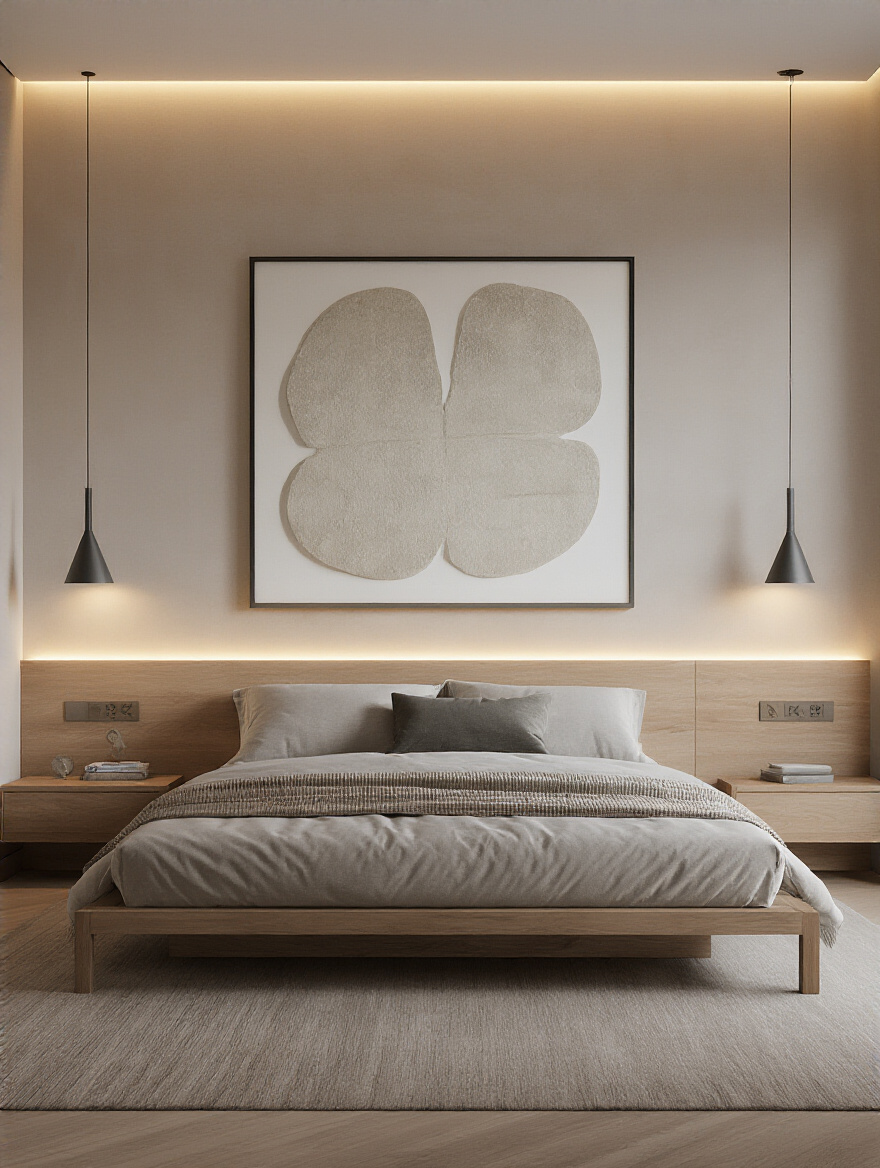
You can create different “scenes” that highlight different pieces of art or set different moods. It’s a way to make your wall art dynamic instead of static. It’s another layer of personalization that allows your room to adapt to your needs from moment to moment, controlled by your voice or a simple tap.
20. Display Personal Photography for an Intimate Touch
I can’t say this enough: your home should tell your story. Filling your most personal space with images of people, places, and moments you love is one of the most powerful things you can do to make a house feel like a home. It’s a visual reminder of your identity, your connections, and your joy.
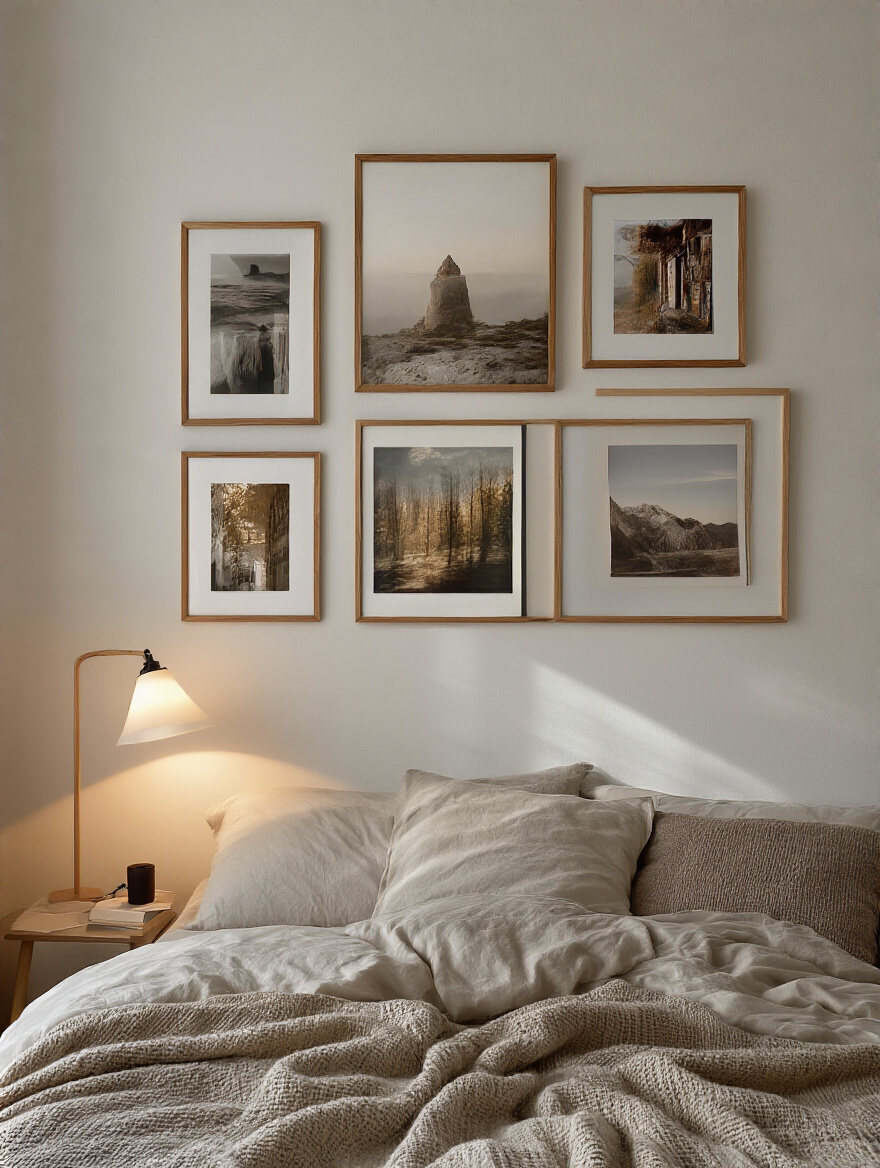
For an older family member, seeing photos of loved ones can be a daily comfort and a memory aid. For you, it can be a source of strength and happiness. Don’t relegate your best photos to a social media feed. Print them, frame them beautifully, and live with them. Let your walls be a celebration of your life.
21. Rotate Seasonal or Temporary Art to Refresh Your Space
Does your bedroom feel a little stale after a while? Instead of a major redecoration, consider rotating your art. It’s the easiest way to give your space a completely fresh feel. You can swap in lighter, brighter pieces for spring and summer, and cozier, moodier art for fall and winter.
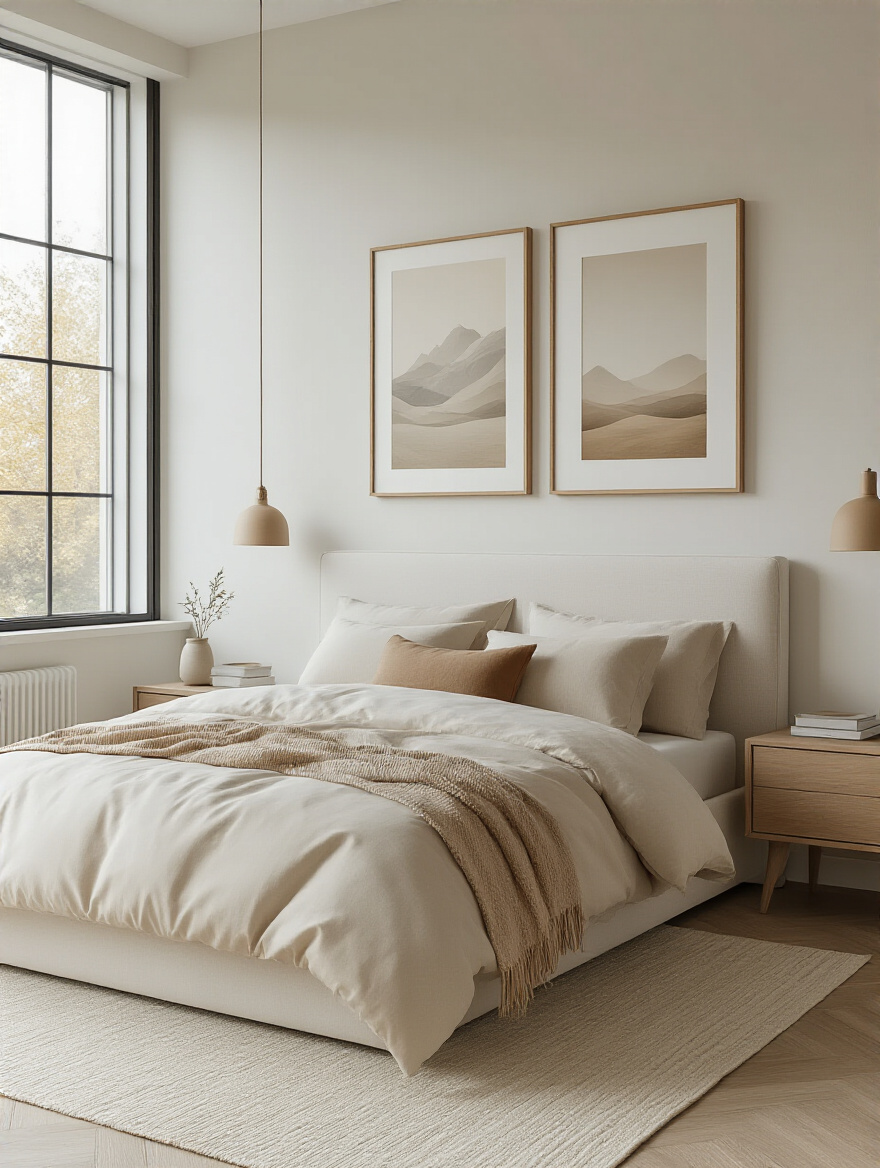
This is where picture ledges or gallery hanging systems are fantastic. They make swapping art incredibly simple. You don’t need a huge collection to do this. Just rotating two or three key pieces can make the whole room feel new again. It keeps your space dynamic and prevents that feeling of “design fatigue.”
22. Avoid Common Wall Art Placement Mistakes
Let’s recap the big three placement mistakes so they stick. First, hanging art too high. It should connect to the furniture below it, not float off into space. Second, choosing art that’s too small. When in doubt, go bigger. It looks more intentional. And third, scattering small pieces randomly. Group them together in a tight, cohesive gallery wall.
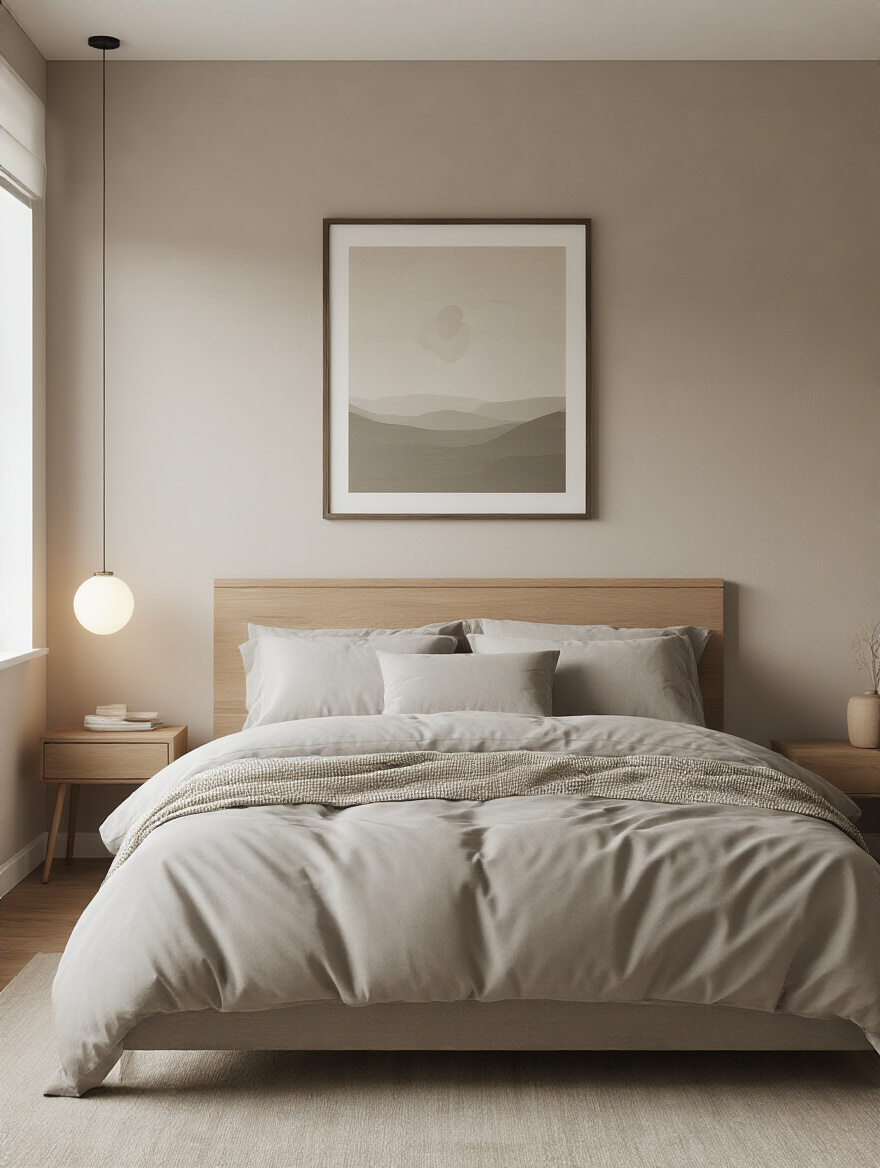
These aren’t just fussy designer rules. They are principles of balance and proportion that help a room feel calm and resolved. A well-placed piece of art anchors a space and brings clarity. An poorly placed one just creates visual noise. Getting the placement right is a free way to make your entire room look better.
Refining & Sustaining: Advanced Personalization and Care (Part 2)
Finally, let’s talk about preserving the beauty of the art you’ve so thoughtfully chosen. A little bit of care goes a long way in ensuring your haven remains beautiful for years to come.
23. Implement Regular Cleaning and Care for Long-Term Preservation
This is the simple, boring advice that makes a huge difference. Dust your art. A soft, dry microfiber cloth or a feather duster once a week is all it takes to keep grime from building up and dulling the colors. Never, ever spray cleaner directly on glass frames—spray it on the cloth first to prevent it from seeping behind the glass and damaging the art.
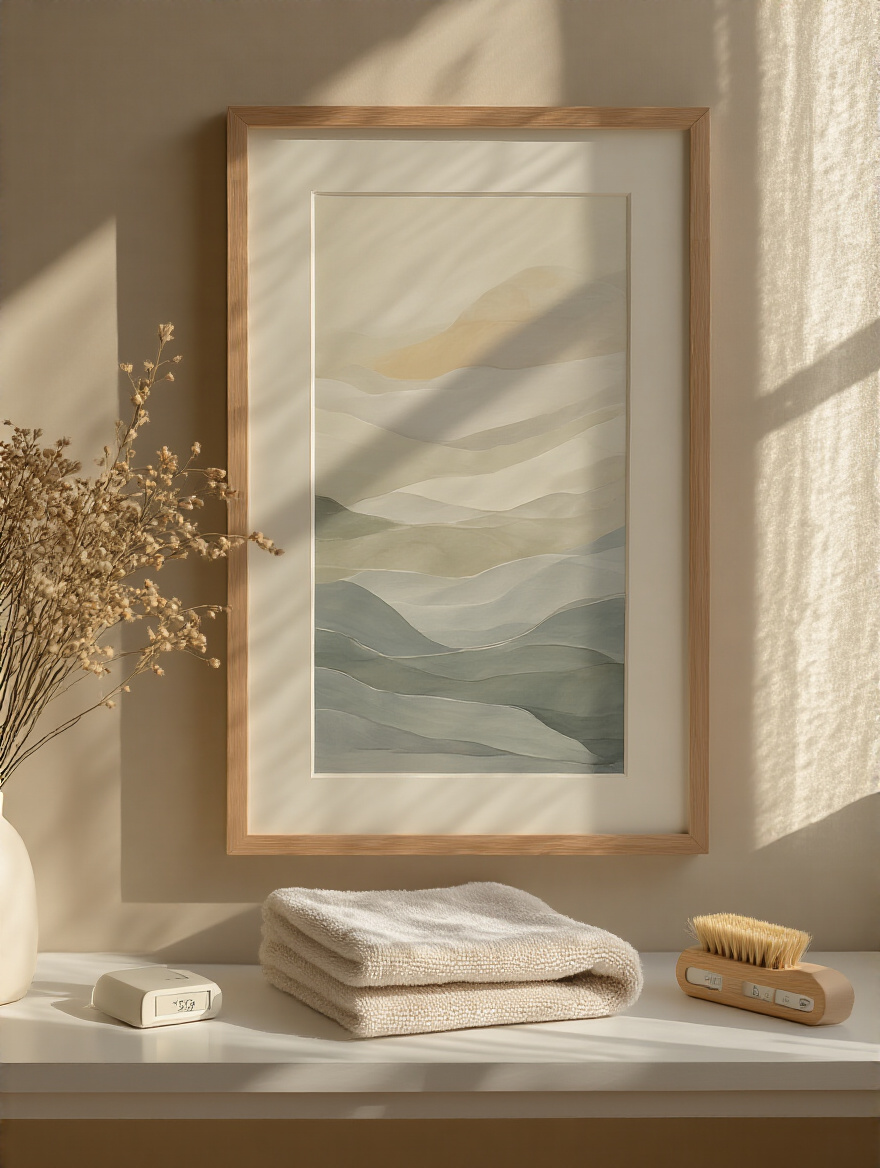
Also, be mindful of direct sunlight. It will fade prints and photographs over time. If a prized piece has to hang in a sunny spot, investing in UV-protective glass for the frame is absolutely worth it. This isn’t about being precious; it’s about respecting the things you love and ensuring they last. Your art is an investment in your well-being, and it deserves a little care.
Conclusion
So there you have it. Choosing bedroom wall art is so much more than just picking something pretty. It’s a chance to build a room that supports, comforts, and inspires you. It’s an opportunity to design with intention, thinking not just about how a room looks, but how it feels and how it functions for everyone who lives there.
Your home is your story. The art on your walls are the illustrations. Let them be personal, let them be meaningful, and don’t be afraid to let them change as your story unfolds. Start with one wall, one idea that resonated with you, and see how it transforms your space. You have the power to create a retreat that is not only beautiful but is a true reflection of a life well-lived.
